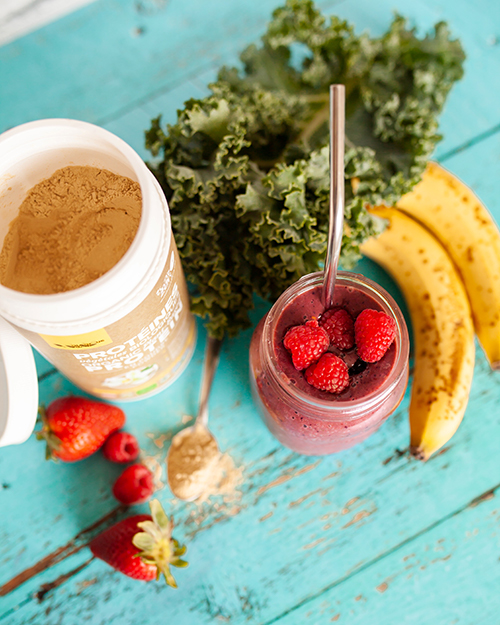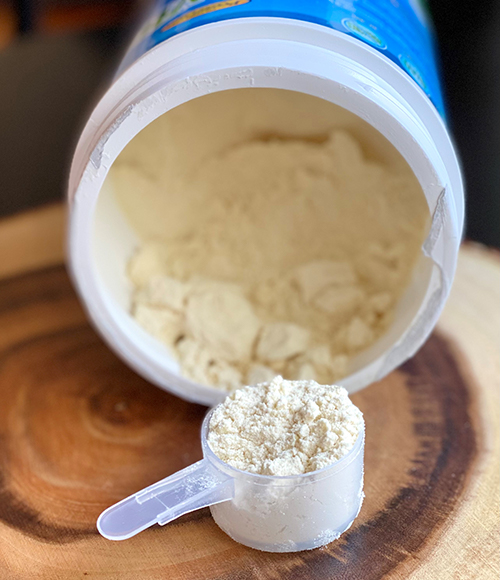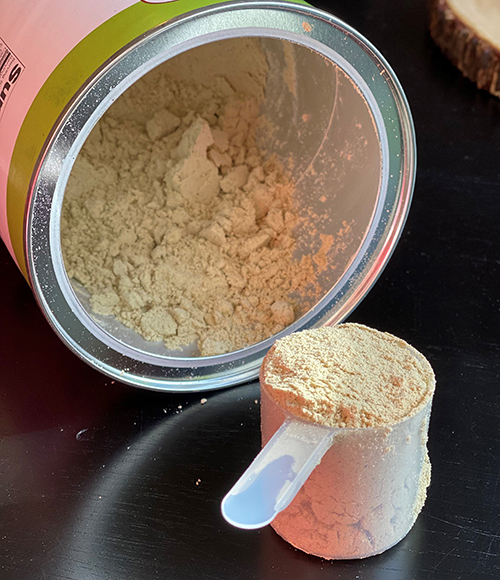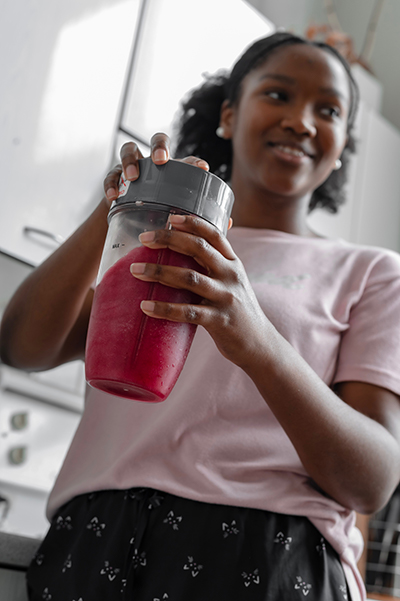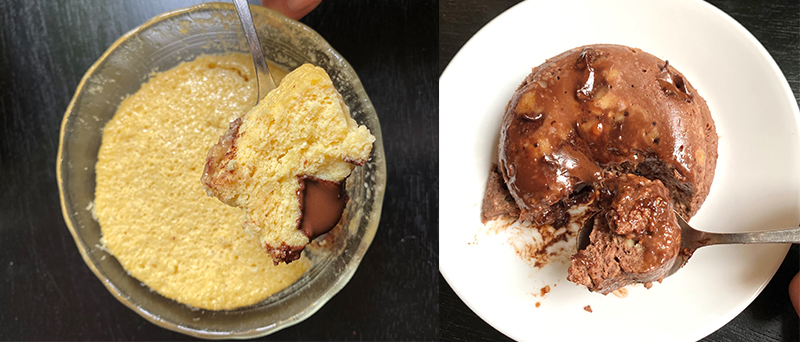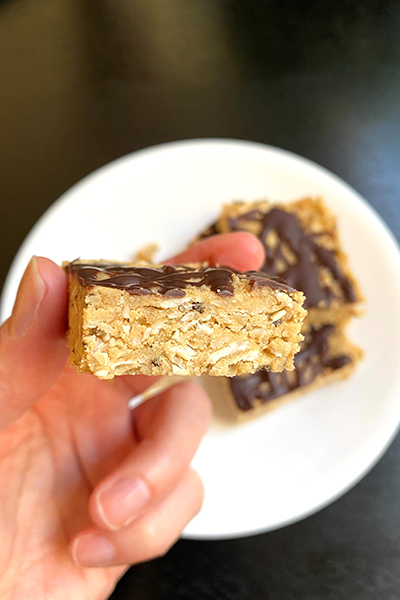Protein powders can be an easy, convenient way to add in more protein. However, if you have ever gone to the store or looked online for a protein powder, then you know there are a lot of options out there! It can be really confusing trying to figure out which one is the right one for you, so let’s take a look at some of the different types of protein powders and some things to look out for.
Quick Note about Protein
A quick protein lesson before we get into the different kinds of protein powders. Protein is made up of amino acids. Our bodies use 20 different amino acids. Seven are non-essential amino acids, meaning our body can make these; four are conditionally essential, meaning our body can usually make these, unless you are sick or possibly after very hard training sessions; and the other nine are essential amino acids, meaning our body cannot make them and we need to get them from our diet. Branched-chain amino acids (BCAA) are a subcategory of the essential amino acids and play an important role in muscle synthesis. A complete protein contains sufficient amounts of all nine essential amino acids.
Bioavailability
Beyond complete and incomplete protein sources, different proteins are utilized differently in our body. Just because something has 25 grams of protein in it, doesn’t mean that our body will absorb 25 grams of protein.
There are several different methods that are used to determine how well our body will utilize protein.
- The Protein Digestibility Corrected Amino Acid Score method (PDCAAS) is based on a determination of protein content, amino acid profile and protein digestibility.
- The Digestible Indispensable Amino Acid Score (DIAAS) is newer and thought to be more accurate. It is also based on amino acid requirements and digestion, but at a different point in our GI tracts.
In general, animal-based protein (except for bone broth and collagen) tend to score the highest while single source plant proteins are on the lower end (except for soy). However, when plant sources are combined (like rice and pea), they can score as high as the animal protein.
What kind of protein powder should I use?
There are plenty of protein powder options to choose from, but the type you choose will ultimately depend on your individual needs, preferences and if you have any allergies, intolerances or food sensitivities. Different protein powders will have different flavors, textures and mixing abilities (some you can just shake; others you will need to blend in a blender). You might have to experiment with a few different ones before you find one that you like.
Animal-Based
- Whey protein is considered the “gold standard” for protein powders due to its high bioavailability and amino acid concentration (highest in BCAA’s). There are different types of whey protein, depending on how it was processed. It is a complete protein.
- Whey protein concentrate tends to be less processed; it will contain a little of the naturally occurring carbohydrates and fats present in the milk, which also means it contains some lactose. If it has been processed without heat (not common), it may also still contain beneficial immunoglobulins.
- Whey protein isolate is further processed to remove most of the carbohydrates and fats, leaving mainly just the protein, which means it is typically lactose-free.
- Hydrolyzed whey protein is broken down even more, almost pre-digested so that your body can absorb and utilize it quicker. It is also lactose-free.
- Casein is a different type of milk protein that digests slower than whey, which may be helpful in certain situations. It is a complete protein.
- Egg white protein is another highly bioavailable complete protein choice.
- Beef protein (HydroBEEF™) is a hydrolyzed protein made from beef. It is a complete protein that also contains some collagen. Interestingly, this patented form of beef protein comes from grass-fed cows raised without added hormones or antibiotics, and is free of GMO grains, grasses and ensilage.
- Bone broth protein and collagen are not complete proteins but do have some potential benefits for our immune system, GI tract, skin and joints. Collagen can easily disappear into coffee or other drinks for an easy protein boost, just make sure to have other protein sources throughout the day.
Plant-Based
Many plant-based protein powders are a mix of at least 2 protein sources to create a more beneficial amino acid profile and to make it a complete protein. If you do buy a single plant protein source, just make sure to have other protein sources throughout the day (as most of us do).
- Pea protein is likely the most popular plant-based protein option. Protein and other nutrient content vary from brand to brand; some are concentrates and some are isolates (isolates typically have more protein). It is not a complete protein.
- Rice protein is a good hypo-allergenic protein option that tends be on the cheaper side. It is not a complete protein.
- Hemp protein powder is simply made by grinding up hemp seeds, so it is rich in fiber and healthy fats. It is not a complete protein.
- Soy protein is another popular plant-based protein option and is a complete protein. There is some controversy around using soy protein isolate on a regular basis. Talk to your provider to see if this is an issue for you.
You can also find flax, pumpkin and sunflower seed protein powders just to name a few more. These all have a “nutty” flavor as you can imagine.
What should I look out for?
Paying close attention to ingredients and not just looking at the nutrition facts label is important when choosing a protein powder. You want to avoid those with a lot of added sugars and artificial sweeteners (most common are sucralose and acesulfame potassium).
Some protein powders can also contain thickeners, emulsifiers, anti-clumping agents, artificial flavors and other unwanted additives.
Then depending on your use and needs, you may also want to avoid other added ingredients like caffeine, creatine and maybe even herbs and additional vitamins or minerals.
Picking a protein powder can be tricky, learn about the differences and what to look for. #saslife Click To TweetConcerns about protein powders
A 2010 investigation from Consumer Reports and a 2018 study by the Clean Label Project found that the majority of protein powders tested had detectable levels of arsenic, cadmium, lead and mercury. Plant-based protein powders tended to be higher, while milk and egg-based powders had lower amounts. Elevated cadmium was higher in chocolate flavored powders, since cocoa is a known source of cadmium. However, for many of these brands it was “detectable” levels, levels below the safety cut off. More recent studies by Consumer Lab have found improvements in the protein powders they tested with only cricket protein powder containing arsenic levels above the safety limit.
As with all supplements, quality can vary greatly from one brand to the next. Choose your brands wisely.
How do I use them?
Smoothies are the go-to option for using protein powders, and for good reason. You can customize a smoothie to your unique preferences and macro needs easily, and there is basically unlimited flavor options by using different fruits, veggies, nuts, seeds, spices, etc.
You can also stir a scoop into your oatmeal or add protein powder to recipes like muffins, cookies, pancakes or mug cakes. It can be tricky adding protein powder to baked goods without destroying the texture though, so you’ll have to do a bit of experimenting. Most recipes might have 1 or 2 scoops of protein for 12 muffins or 6 pancakes, so it might only boost the protein by 5 grams or so per serving. You can also add protein powder to no-bake type treats like granola bars and energy balls.
Experiments
I mostly use protein powder in smoothies but wanted to try out some snack recipes for this blog. Oh boy, there were a lot of recipe fails! Baking with protein powder is tricky! I wanted to find a recipe that gave me a big protein boost, not just slightly upping the protein content.
I tried a muffin recipe, then several mug cake recipes and finally a bar.
The muffin recipe was a fail. I’m not sure what happened. They tasted good, but the texture was more like eating a spoonful of peanut butter, not a muffin. They were just so dense. I used Four Sigmatic peanut butter flavor protein powder for this one.
The mug cakes also did not turn out. I tried two different recipes, vanilla and chocolate. Maybe if I kept playing around with cooking times I could get them better, but I hated to keep wasting all these good ingredients. I tried the vanilla one three times and never got the “light, fluffy, gooey” texture the recipe told me I would have. The chocolate one just tasted like eggs. Ugh. For the mug cakes I used whey protein.
The bar recipe below finally worked and was very tasty. Here are a few more recipes that have been tested by us: Copy Cat RX Bar, Powerful Protein Bar.
Take Home Message
Ideally, we would all get the protein our body needs from real, whole foods. These foods are so much more than just protein. They contain vitamins, mineral, phytochemicals and many other beneficial nutrients. However, there are many reasons we might choose to boost our protein intake with a supplement. Just keep in mind that these protein powders are supplements, meaning they supplement your real, whole food diet.
Coconut and Chocolate Peanut Butter Protein Bars
Recipe Adapted From: Ambitiouskitchen.com
Makes 10 bars
PRINT RECIPE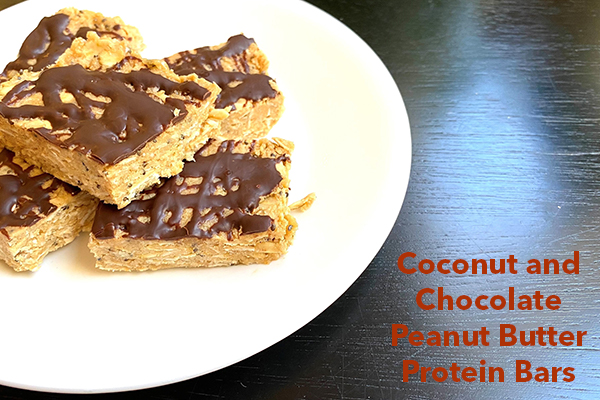
Ingredients
½ cup natural peanut butter (just peanuts + salt)
2 Tbsp coconut oil
2 Tbsp honey or maple syrup
1 tsp vanilla extract
½ cup vanilla protein powder (I used vanilla Vital Whey)
1 cup rolled oats
1 Tbsp chia seeds
⅓ cup unsweetened shredded coconut
2 Tbsp chocolate chips
1 tsp coconut oil
Directions
- Warm peanut butter, 2 Tbsp coconut oil, honey and vanilla in a saucepan over low heat. Mix together until well combined and smooth, then remove from heat and transfer to a large bowl.
- Stir in protein powder until smooth, then fold in oats, chia seeds and shredded coconut.
- Place in a 8x4 inch loaf pan lined with parchment paper.
- Add chocolate chips and coconut oil in a small saucepan and place over low heat until melted. Drizzle over the tops of the bars.
- Place in the fridge for 1 hour before removing from pan and cutting into 10 bars or squares.
- Store bars in the fridge tightly wrapped or in an airtight container for up to 2 weeks.
